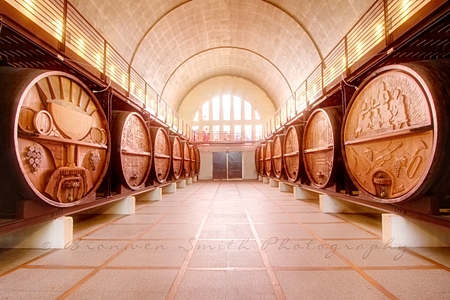Over three hundred and fifty years ago, the first wine grapes were harvested in South Africa. They grew not very far from where modern day Cape Town now stands. The historical heart of South African wine has always been in this region and today most of the country’s wine production takes place in the Cape, particularly the southwest corner near the coastal region.
These two wines come from the prestigious KWV group in South Africa. Established in 1918, KWV is one of the leading wine and spirits producers in the country. Their enormous and renowned cellars in Paarl (including the famous Cathedral Cellar) cover an area of 22 hectares: over 54 acres. More than a hundred different natural wines, as well as brandies and fortified wines are produced here for the international markets.
 KWV’s famous Cathedral Cellar at Paarl.
KWV’s famous Cathedral Cellar at Paarl.
Wines in boxes are convenient and considerably cheaper than buying in bottles. They are also getting better and although there are plenty of cheapies around, some better quality wines are now available in boxes. The Pearly Bay wines are just two of them. Of course the most important thing about wines boxes is that unlike bottled wines, they don’t go off once they’ve been opened. You can keep a half-empty bottle of white in the fridge for a couple of days at the most, after which time the oxidization will render it useless. If, like me you enjoy a glass of dry white wine as an apéritif before dinner, the box is perfect because you can go back to it day after day knowing that the wine will always be fresh.
These two Pearly Bay wines are a bit more expensive than some of the competition, but they’re worth every baht. A three litre box contains the same volume as four standard bottles, so the price is the equivalent of Bt. 226 a bottle, which is considerably cheaper than any bottled wines.
KWV Pearly Bay Cape White, South Africa. (Villa Bt. 906, 3 litre box)
Pearly Bay – also known at Pearly Beach – actually exists. It’s on the southern Cape coast; a vast stretch of heather-covered dunes with a dazzling, pearly white beach.
This is one of the KWV’s best-selling wines and is evidently very popular in Finland, where it’s the top-selling South African brand. Not surprising really, for this wine is young and lively, with a floral aroma of white fruit and a kind of grassy freshness. I could almost smell the sea breeze. But perhaps that’s my imagination. Anyway, it’s a very pleasing fresh dry wine with pears and white fruit on the taste and just enough light acidity to give it an attractive zesty quality. It’s an easy drinker with a crisp, dry citrusy finish and a hint of dried herbs too.
The wine is a blend of predominantly Chenin Blanc and Colombard, both of which hail from France but have become popular in other parts of the world. These grapes are often blended together and make light and fresh floral wines, just like this one.
I’d enjoy drinking this wine on its own, but at just 12% alcohol content, it would work well with light snacks, omelette or salads. It would also help to brighten up the dismal Finnish winters.
Pearly Bay Cape Red, South Africa. (Villa Bt. 906, 3 litre box)
This is a very dark, purplish red wine with interesting and attractive aromas of vanilla, black fruits and berries. There are hints of spice and mint too. It’s quite dry and medium-bodied with a pleasant, smooth mouth-feel. There’s quite a bit of black fruit on the taste and also a pleasant layer of soft, firm tannin.
There is an attractive hint of spice and pepper, the kind of taste you sometimes get from a Shiraz. This, it turns out is not altogether surprising because there’s some Shiraz in the blend, along with the other old favourites, Merlot, and Cabernet Sauvignon.
Although the wine has about 13.5% alcohol content, it’s a very easy-drinker and would be fine with meals like beef casserole, grilled sausages or traditional barbecues.
Oh, and in case you’re wondering, the initials KWV stand for Koöperatiewe Wynbouers Vereniging van Suid Afrika. I am sure you feel much better for knowing that.




